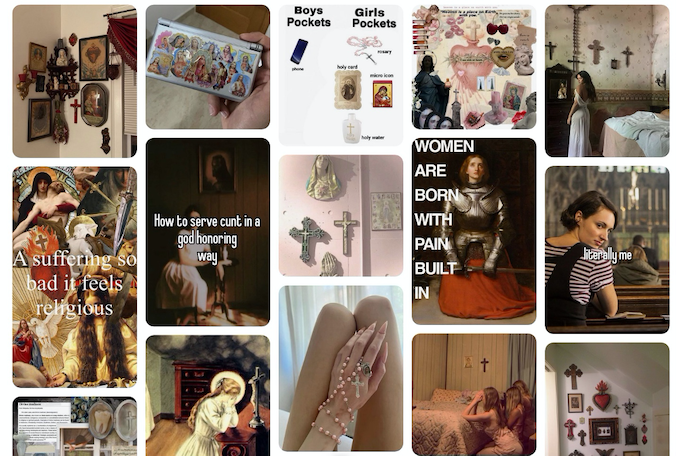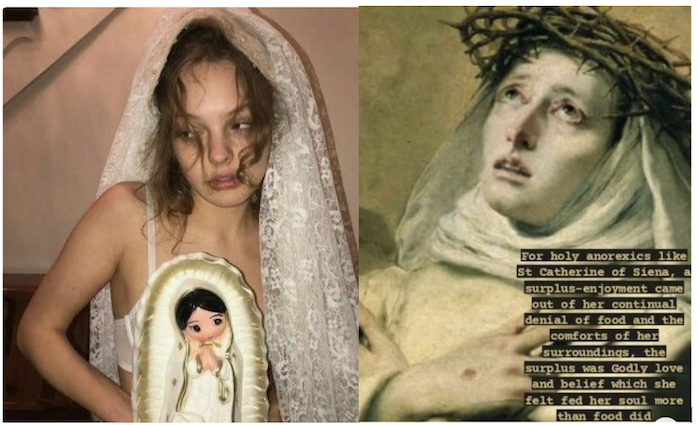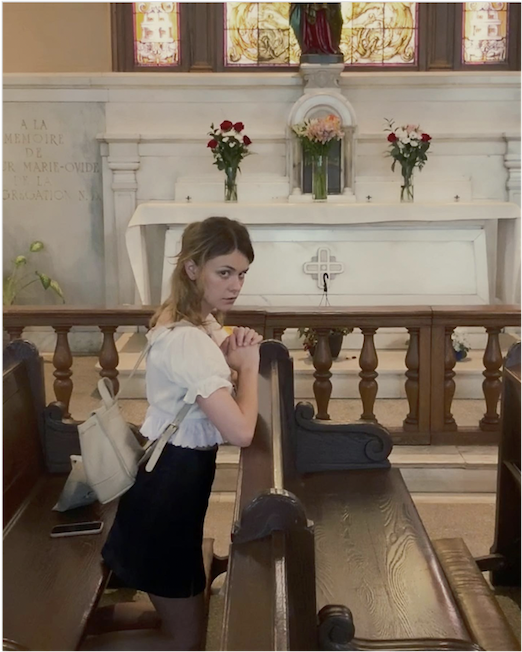The Coquette Catholic Trend
What can this online aesthetic that rejects the tradwife trend for another “trad” expression of femininity tell us about Gen Z, social media, & religion?

(Image source: Mina Le on YouTube)
Engage with Catholic-labeled content on TikTok for a few hours and you’ll see everything from sincere devotional posts to ex-Catholics lambasting the church. You might find funny skits by savvy priests or videos of girls showing you how to veil at Mass. But the one thing you’re guaranteed to encounter is a lot of talk about “aesthetics.”
Such posts feature cathedrals, rosaries, veils, and crucifixes with captions that read “Catholicism is a vibe, honestly” or “my fave aesthetic.” Social media platforms, especially TikTok, have popularized (or appropriated) language from drag culture, so Catholic tradition is often “giving realness” or “slaying”— the caption of one TikTok filmed inside a Spanish cathedral reads “catholicism really used to serve cunt” (a phrase meant to portray confidence or fierceness). Any way you put it, Catholic “tradition” is having a moment on social media.
Some influencers connect the popularity of Catholic aesthetics to the fashion world, citing the 2018 Met Gala’s theme of “Heavenly Bodies: Fashion and the Catholic Imagination,” or recent trends like the fraught “Catholic Mexican Girl” style. Others focus more on sociopolitical context as the driver, explaining the draw to traditional Catholic practices like Latin Mass and rosaries on disillusionment with modern capitalism and consumerism. Online content producers invoke Catholicism, especially that of medieval and early modern Europe, to construct ideas of “tradition” for a wide variety of purposes.
One specific stream of this Catholic social media content is “Coquette Catholic,” which adopts a “girly” Catholic aesthetic often featuring pink rosaries, bows, and vintage charm. Coquette content, created and consumed mostly by women, provides a prime example of a tradition-fueled Catholic aesthetic meeting a thoroughly modern moment shaped by digital hyperconnectivity.

(The author’s Pinterest board. Pinned images were tagged or titled with “coquette Catholic.”)
The rapid spread of this aesthetic offers a compelling case study in how algorithmically driven platforms, especially Instagram and TikTok, are not merely places where people “do” religion, but are actively redefining how people conceive of themselves as religious. Contrary to the notion that Gen Z dismisses tradition in favor of New Age spirituality, the Coquette Catholic trend demonstrates how young women strategically employ traditional elements for their own purposes.
And, importantly, trends like Coquette Catholicism highlight how the constant state of online connection is reshaping how we conceptualize religion and ourselves as religious subjects.
What is “Trad”?
The coquette moment fits within and alongside other “TradCath” content. “Trads,” or traditionalist Catholics, are Catholics who prefer the liturgy and social teaching from before the Second Vatican Council (1962-1965). Some associate Trads with an affinity for the Latin Mass and Gregorian chant, while others focus on their often right-wing political leanings. Famous Trads include people like Kansas City Chiefs kicker Harrison Butker and Vice-Presidential candidate JD Vance, as well as right-wing media personality Candace Owens, who announced her conversion to Catholicism in April 2024.
Some Trads on social media share images of medieval martyrs and cathedrals, and valorize white “Western” civilization. Trad media geared toward men often features Crusader knights and fivefold crosses, while content geared to women often falls into the oft-contested “tradwife” category. Shorthand for traditional wife, this type of content features women performing “traditional gender roles” (however conceived).

(“Trad” content)
But Trads are no monolith. In addition to knights and tradwives, we also see traditionalist Catholics espousing political ideas from monarchism to libertarianism, from socialism to anarchism. From the U.S. to Brazil to Germany, online “Trads” draw upon different items from the archive of Catholicism’s past, often held together in tension with one another, some of which are authorized by the Church’s leadership while others are not.
Similar to but very different from the “tradwife” trend, young women online are drawing on images of medieval saints, Catholic objects and dress, and the current popularity of coquette fashion to create a different kind of trad girl. While the coquette Catholic is decidedly not a tradwife, the content does feature traditional Catholic piety, occasional mentions of Latin Mass, and ostentatious performances of “traditional” femininity.

(#coquette #catholic from Tiktok)
Coquettification of Catholicism
While Coquette Catholic shares some similarities with Trad, it also differs in clear ways. Unlike tradwives, for whom the idea of submission to a husband and having several kids is central, these younger, mostly single women are generally not interested in returning to the 1950s. Cigarettes, Amy Winehouse, and slinky silk nightgowns figure just as prominently as rosaries, pocket altars, and holy cards of St. Catherine of Siena. Pictures of the content creator attending a Latin Mass can be followed by a post that says “Oops! Accidentally slept with my Pilates instructor.” A bit more irreverent but not always insincere, this content does not demand sexual purity in the form of abstinence and heterosexuality (though it might cheekily apologize for being “bad”).
In addition to traditional Catholic piety, coquette Catholic content can draw on the broader coquette aesthetic (bows, hearts, babydoll dresses), southern gothic imagery (moody, disturbing), dark academia (New England prep with a touch of terror) and the internet sad girl of 2010s Tumblr (more on this below).

(Instagram)
Eliza McLamb, singer-songwriter and co-host of the Binchtopia podcast, explains her perception of this aesthetic in her Substack post “Coquette Inclination: A Meditation on Knockoff Tabis, Family, and Coming Back to Tradition.” Reflecting on her own personal journey of self-discovery while going to Mass with her family, McLamb confesses:
“I wear bows sometimes. One time I saw Lana del Rey at a diner in Hollywood and sat silently with tears streaming down my face, overcome with emotion and unwilling to approach her. Whether or not the [Coquette Catholic] movement is “over” or “cringe” or “out” at this juncture is something that I am unable to determine — I’ll leave that to the TikTok trend forecasters — but it’s clear that this cultural fascination, and its intersection with traditional lifestyles and hot-girl Catholicism, has been influential to The Girlies in the fashion realm and otherwise.”
McLamb’s description touches on the malaise that many women who contribute to this aesthetic express in their posts. This melancholy trend, commonly called Sad Girl Culture, emerged on Tumblr during the first half of the 2010s and has had a resurgence on TikTok and Instagram in the last few years. In the original trend, girls shared photos of their bruises, their tears and smudged eyeliner, and sad quotes covered in glitter. This content picked up again with the rise of the broader coquette trend, romanticizing poor mental health, disordered eating, and self-destruction (Fleabag style).

(Coquette Catholic aesthetic and the romanticization of the Sad Girl on Pinterest)
Searches on Pinterest that combine “coquette” with “catholic trauma” or “catholic guilt” result in photos of girls in mini skirts and knit tights broadcasting their suffering, their loneliness, and the impending doom of 21st-century life. Unlike artists such as Madonna or Lady Gaga who have used Catholic material culture subversively, this aesthetic is more in line with Lana del Rey and Ethel Cain — not very orthodox, but also not insincere. In fact, the more you mention philosophy the better. Memes of this subgenre often feature the suffering and torment (both mental and physical) of medieval female saints like Hildegard of Bingen or Catherine of Siena.

(Meme featuring Catherine of Siena)
What can this tell us about Gen Z?
While some scholars and journalists have written about Gen Z rejecting tradition and instead embracing New Age spirituality, the Coquette Catholic trend shows us how young women are using tradition for their own social purposes. Many express the desire for something “real” or “time tested” (which should give us pause for concern since White western civilization tends to mean “tradition” while New Age stuff, often invoking “Eastern” cultures, are labeled as new-fangled).
Whether perceived to be genuine or ironic, the draw to “tradition” is clearly positioned over and against a mix-and-match kind of spirituality. The content largely expresses a desire to at least pretend to be governed or in some way determined (much like the Quantified Self, determined by self-tracking and data). Sometimes the creators themselves explain this as a reaction to hyperconsumerism. Other times they imply an exhaustion with the idea of the neoliberal sovereign self. Even if imagined, “tradition” stands in for constraint, not choice.
McLamb, in her aforementioned Substack, describes this feeling. Looking down during a Latin mass at the bows on her shoes, she writes that she feels like “a girl” trying to go “to the place where [she is] supposed to get better, to be good.” She talks about feeling aimless and overwhelmed in her twenties, musing that this might be why “the young people crave tradition and structure, apparently.” Dasha Nekrasova, actor and host of the “Red Scare” podcast, put it more plainly: “No hell, no dignity.”
But of course, there is choice. Despite being tied to what many describe as “a 2,000-year-old tradition” imagined as a stable institution across time and space, we don’t live in the Middle Ages. We have access to an endless stream of ideas, communities, and things.
McLamb describes the dizzying task of “finding oneself” in the age of the internet. “The classic advice for people,” she argues, “is to center your own experience, focus on developing your own desires, your own tastes. In combination with the internet, this has led to a deathly identity soup.”
On the other hand, algorithmic curation can make some of these choices for you. By analyzing data on user preferences and content performance, these algorithms prioritize content that is likely to be engaging and relevant. Upon searching Coquette Catholic on Pinterest, the algorithm recommended “ideas [I] might love,” including “Southern Gothic,” “Catholic guilt,” and “Just girly things.” TikTok’s algorithm requires even less choice, filling your feed without any active intervention.
Sometimes it feels like “the algorithm” might know you better than you know yourself. This sheer abundance of content and choice can make the idea of the algorithm performing the work of fashioning a self feel comforting. Coating this technodetermism with spiritual language comes naturally to some who have been desiring “tradition” and “constraint” in a liberal world of abundance. God works through the algorithm.
Sincerely held?
Some media outlets have characterized this and other Catholic content as Gen Z “embracing Catholicism,” while others debate their sincerity. But rather than scrutinize church attendance or correct beliefs, this trend shows that sincerity may no longer be the standard by which “authentic” religion is measured (at least for some).
Rather than finding a community (though some no doubt have), coquette Catholics have found a vibe—an aesthetic they connect with. The democratization (at least in the sense of the decline of gatekeepers) brought on by digital hyperconnectivity has not only challenged religious authority, but has also decentered correct “belief” as the main arbiter of religious authenticity. Coquette Catholics are not obligated to conform to previously-authenticated aesthetics approved by authorities to be heard.
For example, “Red Scare” podcast host Dasha Nekrasova has explained that she is Catholic “like Any Warhol.” When asked if her Catholic practice was ironic, Nekrasova answered in the affirmative, but also quipped that “it doesn’t matter because it still works.” Similarly, author Honor Levy argued that “you just do the rituals, and then it becomes real, even if you don’t believe in it.” Some corners of coquette Catholicism feature pictures and quotes from Nekrasova or Levy, drawing on their coquette fashion and their move beyond the ironic-sincere binary.

(Nekrosova on Instagram)
To some, this self-conscious performance might reflect young people’s reliance on aesthetics and trends to create a sense of self. But of course, this has always been the case. Performativity and the social formation of the self are not new concepts—we’ve long recognized how social performance and seeing oneself from the outside are central to identity formation. Digital hyperconnectivity has perhaps made this more obvious, but it has also intensified self-objectification. Sociologist Rogers Brubaker puts it like this:
“[Digital hyperconnectivity] has radically transformed how objects exist in the world and how one becomes an object to oneself, to others, and to suprahuman knowledge systems. In so doing, it has created an entirely new techno-social infrastructure of selfhood: an entirely new ecology within which selves are formed and reformed.”
Constant self-objectification and consumption can make some people question whether their identities are truly authentic, since they are often digitally curated and mediated by technology.
On the other hand, the ironic-versus-sincere binary has begun to crumble with a generation who has grown up with digital performance as a part of everyday life. This particular infrastructure of selfhood has challenged the common idea that authenticity means “unfiltered” or “unmediated”—it makes us hyperaware that everything is mediated. This always-on, always-connected universe of digital content is reshaping our selves and our social worlds, including how we see ourselves as “religious.”
Not all TikTok consumers are on board with the idea of “vibes Catholics,” and of course many condemn this presentation as impure, performative, or heretical. But coquette Catholic content shows that religion is changing.
Perhaps the question to ask, then, is not whether these creators are being ironic or sincere, but rather how platforms like Instagram and TikTok might be starting to reshape the concept of religion itself.
Lauren Horn Griffin is assistant professor in the Department of Philosophy and Religious Studies and the Department of History at Louisiana State University. She is the author of Fabricating Founders in Early Modern England (2023) and is writing a book about Catholic traditionalists online.
Nicole Phillips holds a B.A. in Philosophy and History from Louisiana State University. Her research interests include medieval piety and gender studies.